Africa
MORE DESTINATIONS

MORE DESTINATIONS
TANZANIA
India is the most engaging, colorful, chaotic, spiritual and life-affirming country in the world. It is an assault on the senses – all of them, nearly all of the time. Wonder at the diversity of its cultural riches, from temple sculptures and murals that rival the best of the Italian Renaissance to the artistry of ordinary people in a land where much is still made by hand.
TARANGIRE NATIONAL PARK
HIGHLIGHTS:
Tarangire National Park is home to the majestic boobab trees, elephants, large herds of impala, baboons and giraffe. Lions, serval cats, cheetahs, spotted hyenas, leopards and the rare wild dog are also found in the park. Tarangire is a favorite with birdwatchers due to the diverse bird life numbering 550 species.
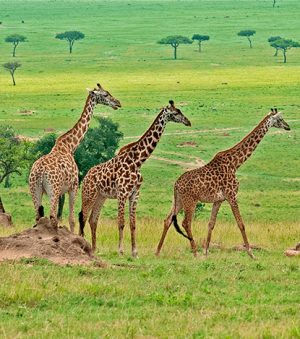
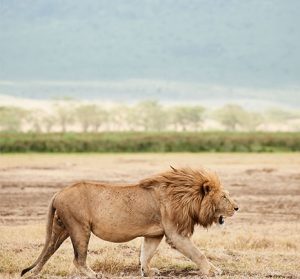
NGORONGORO CRATER HIGHLIGHTS:
Ngorongoro Crater is one of seven World Heritage Sites in Tanzania and is the world’s largest inactive caldera. The crater is 12 miles wide and measures a total of 100 squares miles. The entire rim of the old volcano is intact and has walls of 2,000 feet that surround the caldera floor with an elevation of 5,600 feet. The crater floor provides six distinct habitats: acacia forest, swamp, short- grass, long grass, riverine and woodland. Each habitat attracts a variety of animals. The Crater is home to almost 30,000 animals in an area naturally enclosed by the slopes of the volcano. Despite the high walls of the Crater, approximately 20% of the herd animals do migrate in and out.
Ngorongoro Crater is one of seven World Heritage Sites in Tanzania and is the world’s largest inactive caldera.
The lion population remains rather steady between 55 – 65 individuals. The Crater is also one of the best loactions for viewing black rhino and the huge old bull elephants. For bird watchers, birding in the Crater is a delight, with over 500 recorded species and an ease in exploring different habitats all within rather close range of each other.
Look for the golden-winged and tacazze sunbirds, rufous-tailed weaver, Jackson’s widow bird and pallid harrier, as well as the grey-crested helmut shrike and the beautiful crowned cranes.
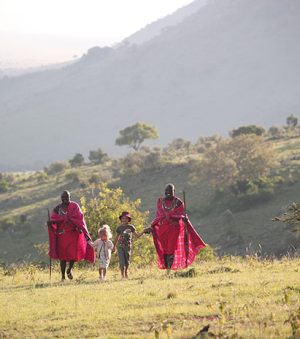
SERENGETI NATIONAL PARK
HIGHLIGHTS:
Recognized as a World Heritage Site, Serengeti National park is one of the most famous wildlife areas in the world and is one of the oldest protected eco-systems. The park itself is 5,700 square miles, but the more extensive Serengeti eco-system is over 9,600 square miles of protected land. The Serengeti is the largest national park in Tanzania, with a staggering animal population of almost four million and 523 recorded species of birds.
It is the largest wildlife sanctuary in the world and the site of one of the most breathtaking events in animal kingdon: the migration of more tha 1.5 million wildebeest and 400,000 zebra.
Serengeti National park is one of the most famous wildlife areas in the world and is one of the oldest protected eco-systems.
The park is a treeless central plain made up of vast savannahs dotted with acacia and granite outcroppings called kopjes with riverine bush and forest in the north.
The park’s name is derived from the Maasai language “SIRINGET” which means endless plains. The famous “Migration” that people dream to experience, is actually a dynamic process taking a full year to complete.
LOLIONDO GAME MANAGEMENT AREA
HIGHLIGHTS:
Visitors to this area can enjoy activities such as night drives, escorted walking safaris and more authentic interactions with the Maasai. This magnificent area contains breathtaking scenery and a vast diversity of landscapes, including beautiful mountais, deep gorges, rivers, acacia and riverine woodlands, rolling hills and lush valleys, grassy plains dotted with rocku outcrops (called kopjes), and even a volcano (OI Donyo Lengai). There is abundant resident game which enjous the region’s many waterholes and river areas, as well as seasonal migratory herds, which pass Loliondo areas on the trek to the southern plains.
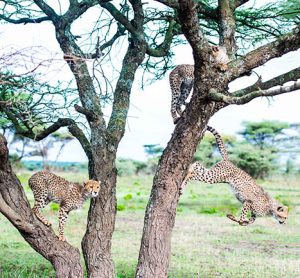
This magnificent area contains breathtaking scenery and a vast diversity of landscapes.
Visitors who are here when the herds decide to cross the Mara River are in for a memorable sight, as thousand of wildebeest and zebra swim for their lives while crocodiles lie in wait for them to try to make this very dangerous crossing. Travelers who venture here have the opportunity to enjoy a more private and intimate experience with the wildlife, and people who live in this spectacular region. Wild dogs have been populating this area as well, but they remain highly endangered.

LAKE MANYARA NATIONAL PARK
HIGHLIGHTS:
Lake Manyara National Park is a small park of only 130 square miles of which 80 square miles consists of a soda lake. Manyara is bordered by the western wall of the Great Rift Valley (3,150 feet altitude) and the shallow alkaline Lake Manyara. The park is notable for elephants, hippos and tree-climbing lions .The park was first made famous by the elephant researcher Ian Douglas Hamilton and Manyara was established specifically to protect the elephants herds. This park has the highest density of elephants boasting 7 elephants per square kilometer. Manyara is a birding paradise more than 400 species are resident all year round.
Lake Manyara National Park is a small park of only 130 square miles of which 80 square miles consists of a soda lake.
The species include a large variety of hornbill species including the huge and colorful ground hornbill, pied kingfisher, white and pink-backed pelicans, hamerkop, crowned eagle, long-created eagle and a lovely variety of bee-eaters, sunbirds and whydah birds. The park is also known for its large troops of baboons and the famous Hippo Pool also providing over 40 species of waterfowl in the area.
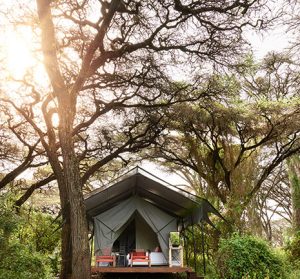
ARUSHA NATIONAL PARK
HIGHLIGHTS:
Arusha National Park is the closet national park to Arusha (36 miles to the East) and situated at the foot of Mount Menu, the second highest peak in Tanzania after Mount Kilimanjaro. The Park comprises 85 square miles of pristine wilderness and has a diverse topography. The park is divided into three distinct areas: Ngurdoto Crater, the Momella Lakes and the rugged Mt Menu and ranges in altitudes between 4,950 feet up to 14,850 at Mount Menu. Ngurdoto Crater is surrounded by forest whilist the crater floor is a swampy area. The Momella lakes, like many in the Rift Valley, are alkaline, while Mt Menu is a mixture of lush forest and bare rocks. Associated with these different vegetation zones are different types of mammal species and outstanding birdlife less likely to be found else where.
Within this wide range of habitats are over 411 species of birds. This Park offers visitors opportunities for a walking safari.
Both migratory and residents water birds settle on the lakes, waterbuck and reedbuck are found near water, while bushbuck and duikers easily glimpsed between ancient cedar trees. Some of the nicest surprises are the black and white Colobs monkey as well as the Blue or Skyes money climbing along the branches in the forested areas. Within this wide range of habitats are over 411 species of birds. This Park offers visitors opportunities for a walking safari.
